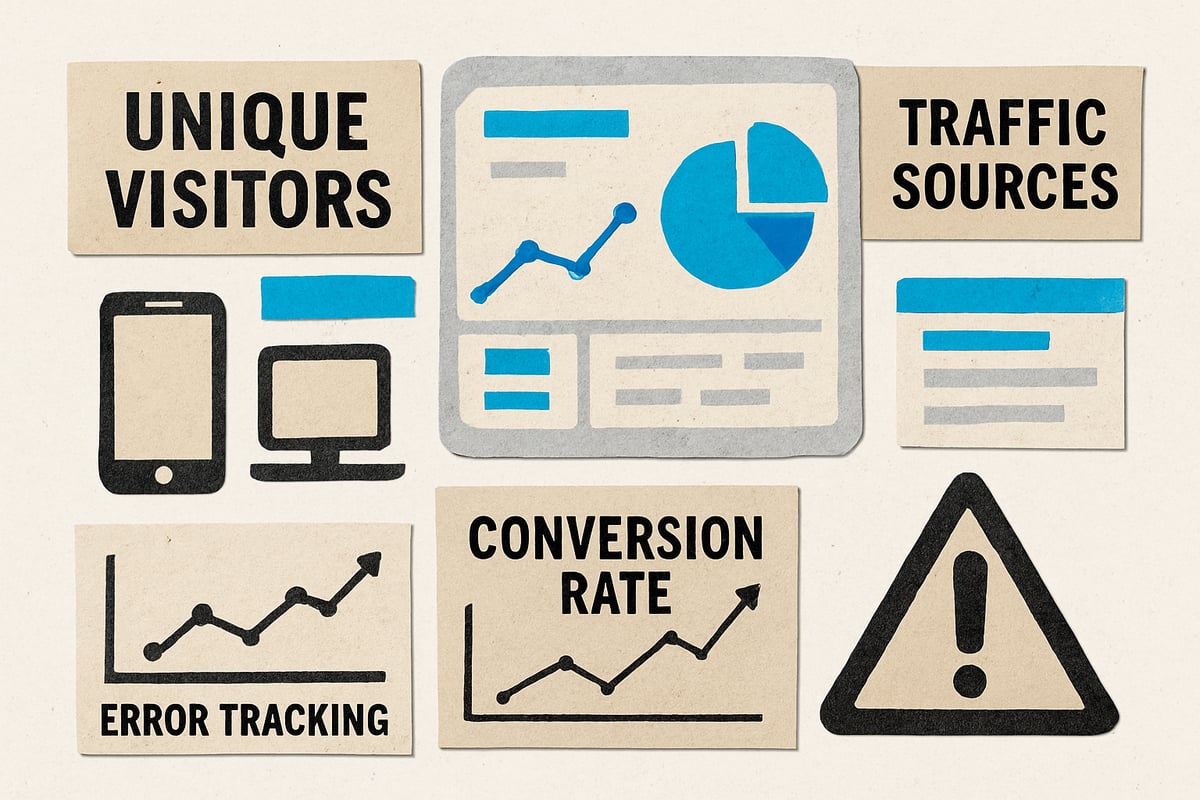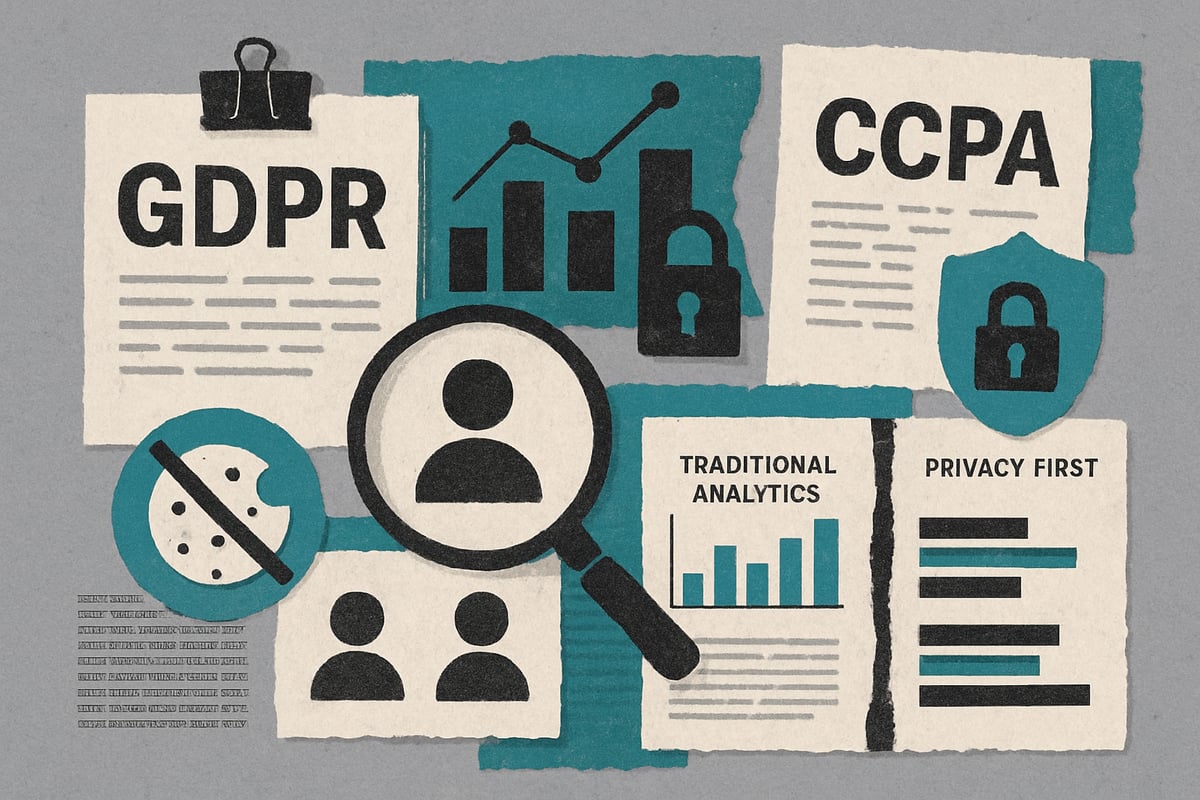- Date
See a Website Traffic: The Essential Guide for 2025
 Andrii Romasiun
Andrii Romasiun
In 2025, digital success depends on how well you see a website traffic and understand what drives visitors to your site. The landscape is evolving fast, with new tools, privacy rules, and user habits changing the game. This essential guide will help you navigate these changes, showing you why traffic analysis matters, which methods and tools to use, how to interpret critical metrics, and how to stay compliant. Ready to unlock actionable insights and drive your website’s growth? Let’s get started.
Why Website Traffic Analysis Matters in 2025
Understanding how to see a website traffic is not just a technical task in 2025—it is a business imperative. As digital landscapes shift rapidly, companies face new challenges and unprecedented opportunities. To stay ahead, organizations must go beyond surface-level stats and leverage in-depth analysis for every aspect of their online presence.

The evolving digital landscape and user behavior
In 2025, user behavior is shaped by AI-driven personalization, mobile-first experiences, and seamless transitions across platforms. People expect instant access, intuitive navigation, and privacy by default.
The need to see a website traffic accurately is heightened by strict privacy regulations. According to Statista (2024), 65% of users are concerned about online tracking. This shift demands analytics solutions that respect privacy while still providing actionable insights.
The business value of knowing your traffic
Comprehensive traffic analysis is the foundation for informed marketing, content, and product decisions. When you see a website traffic clearly, you can measure campaign ROI, adjust content strategies, and develop products your audience wants.
E-commerce brands, for example, have increased conversions by 30% by acting on traffic insights. For a detailed look at how to track and interpret these metrics, visit the Website Traffic and Stats Guide.
Competitor benchmarking and industry trends
Analyzing how you see a website traffic also reveals your position in the market. Benchmarking against competitors uncovers industry trends and highlights areas to improve or defend.
SaaS companies routinely use traffic analysis to outperform rivals. They monitor competitor growth, spot market opportunities, and adapt quickly to shifting trends.
Customer journey optimization
Mapping the customer journey is essential for improving user experience and boosting conversions. By using analytics to see a website traffic patterns, you can identify high-exit pages and optimize them for retention.
This process helps teams understand where users drop off, what content keeps them engaged, and which touchpoints drive the most conversions.
Early problem detection and site health monitoring
Analytics tools are critical for spotting problems before they escalate. When you regularly see a website traffic, you can detect sudden drops, broken user flows, or technical errors.
Research shows that 40% of businesses discover issues via analytics before customers complain. This proactive approach protects revenue and brand reputation.
Compliance and trust in a privacy-first era
Balancing actionable insights with privacy is non-negotiable in 2025. With global frameworks like GDPR and CCPA, organizations must ensure their methods to see a website traffic are ethical and compliant.
Today’s users reward brands that respect their data. Transparent analytics build trust and foster long-term loyalty.
Summary of why traffic visibility is a competitive necessity
In summary, the ability to see a website traffic is a decisive advantage. Businesses that prioritize analytics can adapt faster, serve customers better, and outperform competitors. Those who ignore data risk falling behind in a landscape that rewards agility and insight.
Methods to See a Website’s Traffic: Tools & Techniques
Understanding how to see a website traffic is essential for any digital strategy in 2025. With new tools and privacy requirements, the methods you choose can shape your insights, compliance, and growth. Let’s break down the most effective techniques, from classic analytics to privacy-first solutions.
Built-in analytics solutions (Google Analytics, Matomo, etc.)
To see a website traffic accurately, many start with built-in analytics platforms like Google Analytics or Matomo. These tools provide real-time data, event tracking, and customizable dashboards, making them ideal for most businesses.
| Feature | Google Analytics | Matomo |
|---|---|---|
| Real-time data | Yes | Yes |
| Open-source | No | Yes |
| Privacy focus | Moderate | High |
However, they come with limitations. Google Analytics can raise privacy concerns due to data sharing, while Matomo’s self-hosted model requires more technical skill. Both may sample data, potentially missing granular details. Still, if you want to see a website traffic at scale, these platforms are foundational.
Third-party traffic estimators (SimilarWeb, SEMrush, Ahrefs)
If you need to see a website traffic for competitor sites or industry benchmarks, third-party estimators like SimilarWeb, SEMrush, and Ahrefs are invaluable. These tools estimate traffic by analyzing data from browser plugins, ISP partnerships, and public sources.
For example, SimilarWeb allows B2B SaaS teams to benchmark against rivals, revealing traffic sources and engagement trends. Accuracy varies, so results should be viewed as directional rather than absolute. Still, these platforms are vital for market research and competitive analysis. They enable you to see a website traffic beyond your own properties, helping to identify new opportunities and threats.
Server log analysis
For organizations seeking full control over data, server log analysis is a robust method to see a website traffic. By examining raw log files, you gain direct insights into every request made to your site, bypassing third-party scripts.
A typical log entry might look like:
192.168.1.1 - - [10/Apr/2025:14:32:07 +0000] "GET /index.html HTTP/1.1" 200 1043
This approach offers complete data ownership and no reliance on external vendors. However, interpreting logs requires technical expertise and may not provide the rich user experience insights available in other tools. For those who value privacy and accuracy, server logs remain a trusted way to see a website traffic.
Privacy-focused analytics platforms
The demand for privacy-first analytics has surged, prompting many to seek new ways to see a website traffic without compromising user trust. Modern platforms offer cookieless tracking, anonymized data, and compliance with GDPR and CCPA.
Open-source tools and cloud solutions now let you gather actionable insights while respecting user privacy. Many businesses are turning to Alternatives to Google Analytics to assess which privacy-focused analytics solutions best fit their needs. By choosing compliant tools, you can see a website traffic while meeting global regulations and maintaining transparency.
Swetrix: Privacy-First Analytics for Modern Websites
Swetrix is redefining how organizations see a website traffic in 2025. As a comprehensive, open-source, and privacy-first analytics platform, it offers cookieless tracking, real-time insights, and error monitoring—all without intrusive cookie banners.

Key features include customizable alerts, GDPR compliance, and the option to self-host for complete data ownership. Swetrix empowers teams to see a website traffic in detail, with transparent pricing and robust customer support. It’s ideal for businesses that value privacy, want actionable analytics, and need flexibility to adapt as regulations evolve. With Swetrix, you gain accurate analytics without sacrificing user trust or control.
Manual methods: browser extensions and public data
Sometimes, the fastest way to see a website traffic is with browser extensions or public data sources. Tools for Chrome or Firefox can provide instant traffic estimates with a single click.
Other methods include checking Alexa Rank, leveraging public APIs, or analyzing social signals for rough traffic benchmarks. While less precise, these approaches are useful for quick checks or when deeper access is unavailable. They provide a simple way to see a website traffic trends, especially for small sites or early-stage projects.
Choosing the right tool for your needs
Selecting the best method to see a website traffic depends on your scale, privacy requirements, technical expertise, and reporting needs. Consider:
- The size and complexity of your site
- Compliance with GDPR, CCPA, or other regulations
- The need for real-time versus historical data
- Integration with your existing stack
Review options carefully to ensure you see a website traffic in a way that aligns with your business goals and respects user privacy. The right analytics approach can unlock growth and keep you competitive in 2025.
Key Website Traffic Metrics to Track in 2025
To see a website traffic clearly and make smart decisions, you must focus on the right metrics. In 2025, analytics are more nuanced, and understanding each metric’s role helps you translate raw data into business growth. Let’s break down the essential metrics every site owner should monitor.

Unique visitors vs. pageviews
When you see a website traffic report, two core metrics stand out: unique visitors and pageviews. Unique visitors count the number of distinct individuals who visit your site during a set period. Pageviews, by contrast, measure every time any page on your site is loaded, even if by the same visitor.
For example, if one person visits your blog five times in a day, that’s one unique visitor and five pageviews. Tracking both helps you understand if your audience is growing and how engaged they are with your content.
A spike in pageviews but flat unique visitors often means your current audience is highly engaged. On the other hand, a steady rise in unique visitors signals expanding reach. Both are vital for interpreting how you see a website traffic performance.
Bounce rate and session duration
Bounce rate shows the percentage of visitors who leave after viewing only one page. Session duration measures how long users stay on your site per visit. These metrics reveal how compelling and relevant your content is to your audience.
Industry benchmarks suggest that a bounce rate between 40% and 60% is typical for blogs. If your bounce rate is higher, it may signal weak content or poor user experience. Meanwhile, longer session durations usually mean visitors find value and are exploring more.
When you see a website traffic analytics dashboard, watch for changes in these numbers. A sudden spike in bounce rate could indicate a technical issue, while steady session durations reflect consistent engagement.
Traffic sources and channels
Understanding where your visitors come from is crucial when you see a website traffic report. Main channels include organic search, paid ads, referrals, direct visits, and social media. Each channel offers insight into user intent and campaign effectiveness.
Multi-channel attribution is becoming more sophisticated, helping you see the entire customer journey. For actionable benchmarks and channel breakdowns, explore Website traffic statistics 2025, which offers up-to-date insights on organic and referral trends.
Comparing channel performance lets you allocate resources strategically. For instance, if organic search drives the most engaged users, invest in SEO. If paid channels underperform, consider refining your ad strategy to improve how you see a website traffic impact.
User geography and devices
As you see a website traffic report, user location and device type are more important than ever. In 2024, mobile traffic surpassed desktop for most industries, and this trend only grows in 2025.
By analyzing geography, you can tailor content for local audiences or identify new markets. Device breakdowns inform design decisions—if most visitors use smartphones, ensure your site is mobile-optimized.
These insights help boost engagement and reduce friction, making it easier for users to interact with your site wherever they are.
Conversion rate and goal completions
Conversion rate tracks the percentage of visitors who complete a desired action, such as a sale or signup. Goal completions measure specific milestones, like submitting a contact form or reaching a thank-you page.
To see a website traffic conversion funnel, set up clear goals in your analytics platform. For example, a SaaS company might track onboarding steps to spot where users drop off. Addressing these points can significantly improve overall performance.
Monitoring conversion metrics ensures your site not only attracts visitors but also turns them into customers or leads.
Real-time vs. historical data
Real-time data shows what’s happening on your site right now, while historical data reveals long-term trends and patterns. Both are essential when you see a website traffic dashboard.
Use real-time analytics to catch sudden spikes, drops, or technical problems as they happen. Historical data, on the other hand, is key for monthly reviews, strategy planning, and forecasting growth.
Balancing these perspectives gives you a comprehensive understanding of your site’s health and trajectory.
Error tracking and site performance
Site errors and slow performance can quietly erode traffic and conversions. Tracking 404 errors, page load times, and technical glitches is critical when you see a website traffic report.
Studies show that up to 20% of traffic loss can be linked to performance issues. By monitoring these metrics, you can quickly spot and fix problems before they impact user experience.
Proactive error tracking keeps your website running smoothly and ensures visitors have a positive journey from start to finish.
Privacy, Compliance, and Ethical Analytics in 2025
Adapting to the evolving world of privacy and compliance is essential for anyone who wants to see a website traffic in 2025. With regulations increasing and technology advancing, businesses must rethink how they collect, analyze, and act on user data. Let us explore key considerations shaping ethical analytics today.

The rise of privacy regulations (GDPR, CCPA, ePrivacy)
Digital privacy laws are now a global reality. Regulations like GDPR in Europe, CCPA in California, and emerging ePrivacy directives have changed how businesses see a website traffic. These frameworks demand clear consent, data minimization, and user rights.
The consequences of non-compliance are significant. Fines can reach millions, and reputational damage is often irreversible. Companies must monitor regulatory updates, ensure staff are trained, and audit analytics setups regularly.
Cookieless tracking and anonymous data collection
Traditional web analytics relied heavily on cookies, but privacy-first approaches are replacing them. Cookieless tracking uses anonymized identifiers or server-side methods, letting teams see a website traffic without storing personal data.
This shift is not just about compliance. According to BuiltWith, 70% of EU sites moved to cookieless solutions in 2024. These methods reduce the need for intrusive banners, streamline user experience, and maintain valuable insights for optimization.
Data minimization and user consent
Collecting only what you need is now best practice. When you see a website traffic, focus on essential metrics and avoid unnecessary personal details. Transparent consent mechanisms, such as clear opt-in forms, help build trust.
For readers new to these concepts, What is Web Analytics offers a practical introduction to how analytics and consent intersect. Always provide users with granular choices and honor their preferences.
Balancing actionable insights with ethical responsibility
Data-driven decisions are powerful, but ethics must guide every step. Businesses that see a website traffic ethically foster user trust and long-term loyalty. Transparency about what is collected, why, and how it is used is paramount.
Brands leading in privacy-first analytics often share their data practices openly and invite feedback. This approach not only meets legal standards but also differentiates organizations in a crowded digital landscape.
Choosing compliant analytics platforms
Selecting the right tools is crucial. Platforms should offer features like cookieless tracking, robust access controls, and self-hosting options for sensitive industries. Open-source solutions are popular for those needing full control when they see a website traffic.
A compliance checklist might include:
- GDPR and CCPA certification
- Data residency options
- Anonymization by default
- Transparent privacy policies
Review platforms regularly to ensure ongoing alignment with global standards.
Trends shaping the future of analytics privacy
The future of how we see a website traffic is defined by innovation and regulation. AI-powered anonymization, edge analytics, and continual updates to privacy laws will drive new best practices.
Staying agile with analytics means investing in education, monitoring legal changes, and evolving your stack as needed. Ethical analytics is not a one-time project, but an ongoing commitment to users and stakeholders.
Step-by-Step Guide: How to See and Analyze Your Website Traffic
Understanding how to see a website traffic and turn raw numbers into actionable insights is vital for success in 2025. This step-by-step guide will walk you through setting up analytics, defining meaningful goals, monitoring patterns, and reporting your findings. By following these best practices, you will transform your data into growth opportunities.
Step 1: Set up your analytics platform
Begin by selecting the right tool to see a website traffic. Choose between established platforms like Google Analytics, privacy-first solutions, or open-source alternatives based on your needs.
- Install required tracking scripts or set up server-side analytics.
- Configure settings for privacy compliance from day one.
- Test your setup with real-time data to ensure accurate tracking.
Proper setup ensures you capture reliable data, which is the foundation for every insight you will gain.
Step 2: Define your key metrics and goals
To effectively see a website traffic, outline what matters most for your business. Are you tracking sales, leads, signups, or engagement?
- List your primary business objectives.
- Map these objectives to specific analytics goals or events.
- Set up custom events, such as SaaS onboarding steps or e-commerce checkouts.
Clear goals make your data meaningful and enable focused analysis.
Step 3: Monitor real-time and historical data
Regularly review both live and past data to see a website traffic trends and catch sudden changes.
- Use dashboards for daily traffic checks.
- Schedule monthly reviews for broader trends.
- Watch for spikes, drops, or anomalies that may indicate technical issues or campaign impacts.
Combining real-time monitoring with historical context helps you respond quickly and plan strategically.
Step 4: Segment and analyze your audience
Audience segmentation is crucial when you see a website traffic. Break down visitors by source, device, geography, and behavior.
- Identify which channels drive the most engaged users.
- Analyze device usage to optimize for mobile or desktop.
- Discover new market opportunities by location or referral source.
For deeper insights into user behavior, explore User Insights and Analysis to turn traffic data into actionable strategies.
Step 5: Identify patterns and optimization opportunities
Look for recurring trends and areas for improvement as you see a website traffic. Spot high-performing content and bottlenecks in your conversion funnel.
- Pinpoint which pages attract or lose visitors.
- Use A/B testing tools to experiment with changes.
- Address technical issues like slow load times or 404 errors.
Regular analysis fuels ongoing optimization and growth.
Step 6: Report and act on your findings
Summarize your discoveries and turn them into action. When you see a website traffic, effective reporting helps stakeholders understand progress and guides decision-making.
- Create concise reports with visualizations.
- Compare your data to website traffic benchmarks by industry for context.
- Set quarterly reviews to adjust strategy and celebrate wins.
Actionable reporting ensures your team stays aligned and motivated.
Step 7: Stay updated with analytics trends and compliance
The digital landscape evolves quickly. To see a website traffic effectively in 2025, stay current with analytics tools, privacy regulations, and industry best practices.
- Subscribe to analytics blogs and newsletters.
- Attend webinars or conferences on data privacy and analytics.
- Regularly review and update tracking to maintain compliance.
Continuous learning keeps your analytics approach future-proof and effective.
Leveraging Traffic Insights for Website Growth
Unlocking the full potential of your website starts with knowing how to see a website traffic and interpret its insights. In 2025, leveraging this data is not just about numbers, but about actionable strategies that drive measurable business growth.
Using Data to Inform Content and SEO Strategy
Understanding how to see a website traffic allows you to pinpoint high-performing pages and spot keyword opportunities. Analyzing which content attracts the most visitors helps refine your editorial calendar and SEO focus.
For example, businesses that regularly review traffic data often find new topics that resonate with their target audience, leading to an increase in organic visits. Referencing global internet users statistics can also provide context for emerging trends that shape your content approach.
Optimizing Marketing Campaigns Based on Traffic Data
Every marketing dollar counts. When you see a website traffic breakdown by source, you gain clarity on which campaigns generate the highest ROI.
Use traffic segmentation to compare the effectiveness of paid ads, email outreach, and social media. A/B testing landing pages, based on real visitor behavior, enables you to refine messaging and design for maximum impact. This data-driven approach ensures your marketing efforts remain agile and cost-effective.
Improving User Experience and Conversion Rates
A seamless user journey is vital for engagement and conversions. By analyzing how users interact with your site, you can see a website traffic flow, identify friction points, and prioritize UX improvements.
For instance, reviewing mobile website traffic trends shows that mobile visitors now outnumber desktop users in most sectors. Optimizing for mobile responsiveness, clear navigation, and fast load times directly supports higher retention and lower bounce rates.
Detecting and Resolving Technical Issues Proactively
Traffic analytics are essential for early problem detection. Sudden drops in visits or spikes in exit rates often signal technical glitches, broken links, or server issues.
When you see a website traffic anomaly, use real-time dashboards and automated alerts to respond quickly. Proactive monitoring helps prevent revenue loss and protects your brand reputation.
Personalizing User Journeys for Higher Retention
Personalization is a proven driver of loyalty. By segmenting your audience based on behavioral data, you can see a website traffic pattern that reveals preferences and unique needs.
Tailor content, product recommendations, and offers to specific user segments. This targeted approach increases repeat visits and fosters deeper engagement throughout the customer lifecycle.
Measuring and Celebrating Growth Milestones
Tracking progress is vital for motivation and strategic planning. Set clear benchmarks and use analytics to measure improvements in traffic, conversions, and engagement.
Celebrate wins, such as reaching new visitor milestones or boosting time on site. Sharing these achievements with your team builds momentum and highlights the value of your analytics investment.
Preparing for the Future: Evolving Your Analytics Stack
The digital landscape is always changing, so your approach to see a website traffic must evolve, too. Stay informed about new analytics platforms, integration opportunities, and privacy regulations.
Adopting flexible, privacy-first tools ensures your growth strategies remain effective and compliant. Continuous learning and adaptation are the keys to long-term website success.
As we look ahead to 2025, making sense of your website traffic is about more than just numbers—it is about turning real user insights into growth, all while respecting privacy and compliance. If you are ready to move beyond outdated analytics and want a straightforward, privacy-focused way to truly understand your audience, it is time to explore a modern solution. Swetrix gives you the detailed, actionable data you need, without sacrificing user trust or facing compliance headaches. Take control of your analytics journey and Try Swetrix today to see how simple, ethical tracking can help your website thrive.